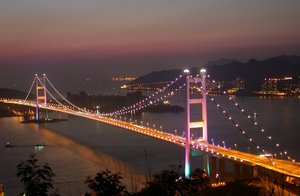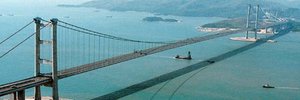Tsing Ma Bridge
|
|
Tsing Ma Bridge (青馬大橋) of Hong Kong is the world's sixth largest suspension bridge. It has two decks and carries both road and rail traffic. The upper deck carries a dual three-lane carriageway and there are two tracks of railway and a two-lane emergency roadway in the lower deck for maintenance and the diversion of traffic during high winds. It has a main span of 1,377 metres (4,518 ft) (more than the famous Golden Gate Bridge in San Francisco) and a height of 206 metres (676 ft). The span is the largest of all bridges in the world carrying rail traffic.
The 40m wide bridge deck carries six lanes of automobile traffic, three lanes in each direction. The lower level contains two rail tracks and two protected emergency lanes for road traffic. There are also two sheltered carriageways on the lower deck for maintenance access and as backup for traffic when particularly severe typhoons strike Hong Kong. Though car traffic would need to be closed in that case, trains could still get through in either direction. Along with the Ting Kau Bridge and Kap Shui Mun Bridge, it is closely monitored by the Wind and Structural Health Monitoring System (WASHMS).
The Tsing Ma Bridge links Tsing Yi Island on the east to Ma Wan island on the west. It is part of the Lantau Link, which, with three long span bridges links the New Territories and Chek Lap Kok, where the Hong Kong International Airport is located. The other two bridges are the Kap Shui Mun Bridge linking Ma Wan to Lantau Island, and the Ting Kau Bridge, linking Tsing Yi Island and Tuen Mun.
Tsingmabridge.jpg
The rail line is part of MTR's Tung Chung Line and Airport Express.
Construction work of the bridge began in May 1992 and ended in May 1997. It cost HK$7.2 billion. The Lantau Link, of which the bridge is an integral part, was opened on April 27, 1997. The ceremony was inaugurated by the former British Prime Minister Margaret Thatcher.
Surveillance cameras were installed over the bridge to record traffic conditions. The video is available at the government website[[1] (http://traffic.td.gov.hk)]. It is updated every two minutes.
The Tsing Ma Bridge has been an important gateway to Lantau. It will become part of the planned Route 8 expressway, which will connect the Lantau Link, the West Kowloon expressway, Cheung Sha Wan and Shatin.
| Contents |
Five major components in its construction
- Foundations and the construction of the bridge tower - one tower located on Tsing Yi side and the other on a man-made island 120 m from the coast of Ma Wan Island. Both towers are 206m above sea level and founded on relatively shallow bedrock. The towers are two-legged with trusses at intervals, in the form of portal beam design. The legs were constructed with high-strength concrete of 100 MPa strength, using a slipform system in a continuous operation.
- Anchorages - the pulling forces in the main suspension cables is taken up by large gravity anchorages located at both ends of the bridge. They are massive concrete structures deeply seated on bedrock on the landside of Tsing Yi and Ma Wan island. The total weight of concrete used in the two anchorages is about 300,000 tonnes.
- Main cables - The cables were constructed by an aerial spinning process. The process involved drawing wires from a constant-tension supply, and pulling loops of these wires from one anchorage to the other, passing a 500-tonne cast-iron saddle on top of each bridge tower seating the cable. A total of 70,000 galvanised wires of 5.38 mm diameter were placed and adjusted to form the 1.1 m diameter main cable.
- Suspended deck - The steelwork for the deck structure was fabricated in Britain and Japan. After delivery, they were further processed and assembled in Dongguan of China into standard deck modules. A total of 96 modules, each 18 m long and about 480 tonnes in weight, were prepared. These deck modules were brought to the site by specially designed barges and raised into the deck position by a pair of strand jack gantries that could manoeuvre along the main cable.
- Approach span on Tsing Yi side - similar in form and cross-section to the suspended deck, but the approach span was supported on piers instead of cable-support. The first span was assembled on the ground and raised into position using strand jacks. Further erection then proceeded in cantilever in smaller sections, using derrick cranes stationed on the deck level. An expansion joint which allowed for a maximum thermal movement of 850 mm was also provided and located inside the approach span section.
The wind tunnel
The objectives of the wind tunnel studies were to demonstrate the safety of the structure under construction and once completed, both with respect to aerodynamic stability as well as the possible effects of extreme typhoon wind speeds. A further objective was to provide dynamic response data at several key locations to compare with full scale data from the ongoing monitoring program, conducted by the Highways Department of Hong Kong.
It is a 1 to 80 scale section model of the deck in the erection stage and 1 to 400 scale full aeroelastic model of the entire bridge. It is a Monte-Carlo simulation of the typhoon wind climate. The full model was tested in different stages of construction in turbulent boundary layer flow, complete with the local topography in order to model the wind conditions at the site. The model tests identified critical stages of erection that allowed the construction schedule of the bridge to be tailored to avoid the typhoon season. The comparison of model test results and the full scale monitoring will assist engineers to better understand the behaviour of long span bridges in wind and to improve current design methods.
As a tourist sight
Tsing Ma Bridge becomes a favourite scenic spot as well as a famous landmark. In order to watch and get further information about it, one can go to the Lantau Link Visitor Centre and Viewing Platform (http://www.info.gov.hk/napco/visitors.html) which is located at the northwest corner of Tsing Yi Island, which is just next to the Bridge's Tsing Yi end. The model, pictures and the structure of the Lantau Link are on display at the Centre. The Visiting Centre is opened from 10:00 am to 5:00 pm on weekdays; from 10:00 am to 6:30 pm on Saturdays, Sundays and most of the public holidays. From the Scenery Viewing Platform, one can also see the Ting Kau Bridge and Kap Shui Mun Bridge. They are the other two bridges listed in the world's "Three Mosts" as well.
Visitors can also have a different spot at the Airport Core Program (ACP) Exhibition Centre (http://www.info.gov.hk/napco/exhibition.html) located about 2 km north of the Bridge.
There is no sidewalk on the Bridge. Parking is also prohibited on this gigantic Bridge.
Ways to get there
To the bridge
Travelling on an automobile is the only way to travel along the upper deck of the Bridge. The cheapest way is to take a bus running between the Hong Kong International Airport (or Tung Chung as well) and the city. These Citybus and Long Win Bus routes are having route number suffixes "A" and "E".
To the Visitor Centre and Viewing Platform
Only cars are taxis can reach the View Point. Taxi can be caught at the nearest railway station: Tsing Yi MTR Station.
To the ACP Exhibition Centre
To get there, visitors can take bus routes 234B or 53 near the Tsuen Wan MTR station.
Operating hours of architectural lighting
At night, there is an architectural lighting which makes the bridge even more gorgeous. The operating hours of the lights are as follows:
Monday to Sunday: 6:00 p.m. to 12:00 midnight (October February) and 7:30 p.m. to 12:00 midnight (March September)
Special Event: 6:00 p.m. to 1:00 a.m. of the following day (October February) and 7:30 p.m. to 1:00 a.m. of the following day (March September)
Toll & Fee
The double tolls for motor cycle, private car, public double-decked bus and heavy goods vehicle are HK$20, $30, $60 and $80 respectively.
Traffic speeds
There are speed restrictions on the bridge. The maximum speed limit is usually 80 km/h for automobiles. Such speed limit may be lowered upon roadwork or under strong wind. Traffic may also be directed to the sheltered carriageways on the lower deck when there are strong winds.
See also
- Transportation in Hong Kong
- List of buildings, sites and areas in Hong Kong
- List of largest suspension bridges
External Links
- Detailed information about the structure of Tsing Ma Bridge (http://www.structurae.net/en/structures/data/s0000082/index.cfm)
- Tsing Ma Bridge description from City University, Hong Kong (http://www.cityu.edu.hk/CIVCAL/book/bridge.html)
- Tsing Ma Bridge description from HK Polytechnic University (http://www.cse.polyu.edu.hk/~ctbridge/case/tsingma.htm)
- Tsing Ma Bridge description from Oriental Travel (http://www.orientaltravel.com/province/city/area/HK_Tsing_Ma_Bridge.htm)
- Live image of Tsing Ma Bridge (http://traffic.td.gov.hk/)
- Tsing Ma Management Limited (http://www.tsingma.com.hk)
- Tsing Ma Bridge Photo Gallery (http://www.pbase.com/alex1030/tsing_ma_bridge)
- Road and rail network to Chak Lap Kok Airport (http://www.hyd.gov.hk/eng/major/road/road/airport.htm)ru:Цзин Ма


